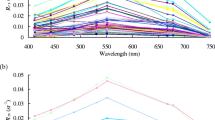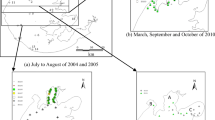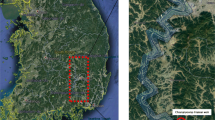Abstract
Based on in situ water sampling and field spectral measurement from June to September 2004 in Lake Chagan, a comparison of several existing semi-empirical algorithms to determine chlorophyll-a (Chl-a) content was made by applying them to the field spectra and in situ chlorophyll measurements. Results indicated that the first derivative of reflectance was well correlated with Chl-a. The highest correlation between the first derivative and Chl-a was at 680 nm. The two-band model, NIR/red ratio of R710/670, was also an effective predictor of Chl-a concentration. Since the two-band ratios model is a special case of the three-band model developed recently, three-band model in Lake Chagan showed a higher resolution. The new algorithm named reverse continuum removal relies on the reflectance peak at 700 nm whose shape and position depend strongly upon chlorophyll concentration: The depth and area of the peak above a baseline showed a linear relationship to Chl-a concentration. All of the algorithms mentioned proved to be of value and can be used to predict Chl-a concentration. Best results were obtained by using the algorithms of the first derivative, which yielded R 2 around 0.74 and RMSE around 6.39 μg/l. The two-band and three-band algorithms were further applied to MERIS when filed spectral were resampled with regard to their center wavelengths. Both algorithms showed an adequate precision, and the differences on the outcome were small with R 2 = 0.70 and 0.71.
Similar content being viewed by others
References
Arenz, R. F., Lewis, W. M., & Saunders, J. F. (1996). Determination of chlorophyll and dissolved organic carbon from reflectance data for Colorado reservoirs. International Journal of Remote Sensing, 17, 1547–1566. doi:10.1080/01431169608948723.
Dall’Olmo, G., & Gitelson, A. A. (2006). Effect of bio-optical parameter variability and uncertainties in reflectance measurements on the remote estimation of chlorophyll-a concentration in turbid productive waters: Modeling results. Apply Optics, 45, 3577–3592. doi:10.1364/AO.45.003577.
Dekker, A. G., Malthus, T. J., & Seyhan, E. (1991). Quantitative modeling of inland water quality for high resolution MSS systems. IEEE Transaction on Geoscience and Remote Sensing, 29, 89–95. doi:10.1109/36.103296.
Doerffer, R., & Schiller, H. (2007). The MERIS Case 2 water algorithm. International Journal of Remote Sensing, 28, 517–535. doi:10.1080/01431160600821127.
Duan, H., Zhang, Y., Zhang, B., Song, K., Wang, Z., Liu, D., et al. (2008). Estimation of chlorophyll-a concentration and trophic states for inland lakes in Northeast China from Landsat TM data and field spectral measurements. International Journal of Remote Sensing, 29, 767–786. doi:10.1080/01431160701355249.
Feng, H., Campbell, J. W., Dowell, M. D., & Moore, T. S. (2005). Modeling spectral reflectance of optically complex waters using bio-optical measurements from Tokyo Bay. Remote Sensing of Environment, 99, 232–243. doi:10.1016/j.rse.2005.08.015.
Fraser, R. N. (1998). Hyperspectral remote sensing of turbidity and chlorophyll a among Nebraska Sand Hills lakes. International Journal of Remote Sensing, 19, 1579–1589. doi:10.1080/014311698215360.
Giardino, C., Pepe, M., Brivio, P. A., Ghezzi, P., & Zilioli, E. (2001). Detecting chlorophyll, Secchi disk depth and surface temperature in a sub-alpine lake using Landsat imagery. The Science of the Total Environment, 268, 19–29. doi:10.1016/S0048-9697(00)00692-6.
Gitelson, A. (1992). The peak near 700 nm on radiance spectra of algae and water: Relationship of its magnitude and position with chlorophyll concentration. International Journal of Remote Sensing, 13, 3367–3373. doi:10.1080/01431169208904125.
Gitelson, A., Garbuzov, G., Szilagyi, F., Mittenzwey, K.-H., & Karnieli, A. (1993). Quantitative remote sensing methods for real-time monitoring of inland waters quality. International Journal of Remote Sensing, 14, 1269–1295. doi:10.1080/01431169308953956.
Gitelson, A., Laorawat, S., Keydan, G., & Vonshak, A. (1995). Optical properties of dense algal cultures outdoors and its application to remote estimation of biomass and pigment concentration in Spirulina platensis. Journal of Phycology, 31, 828–834. doi:10.1111/j.0022-3646.1995.00828.x.
Gitelson, A. A., Dall’Olmo, G., Moses, W., Rundquist, D. C., Barrow, T., Fisher, T. R., et al. (2008). A simple semi-analytical model for remote estimation of chlorophyll-a in turbid waters: Validation. Remote Sensing of Environment, 112, 3582–3593. doi:10.1016/j.rse.2008.04.015.
Gitelson, A. A., Gritz, Y., & Merzlyak, M. N. (2003). Relationship between leaf chlorophyll content and spectral reflectance and algorithms for nondestructive chlorophyll assessment in higher plant leaves. Journal of Plant Physiology, 160, 271–282. doi:10.1078/0176-1617-00887.
Gordon, H. (1979). Diffusive reflectance of the ocean: The theory of its augmentation by chlorophyll-2a fluorescence at 685 nm. Applied Optics, 18, 1161–1166.
Gower, J. F. R., & Borstad, G. A. (2004). On the potential of MODIS and MERIS for imaging chlorophyll fluorescence from space. International Journal of Remote Sensing, 25, 1459–1464. doi:10.1080/01431160310001592445.
Han, L. (2005). Estimating chlorophyll-a concentration using first-derivative spectra in coastal water. International Journal of Remote Sensing, 26, 5235–5244. doi:10.1080/01431160500219133.
Han, L., & Rundquist, D. C. (1997). Comparison of NIR/RED ratio and first derivative of reflectance in estimating algal-chlorophyll concentration: A case study in a turbid reservoir. Remote Sensing of Environment, 62, 253–261. doi:10.1016/S0034-4257(97)00106-5.
Han, L., Rundquist, D. C., Liu, L. L., & Fraser, L. N. (1994). The spectral responses of algal chlorophyll in water with varying levels of suspended sediment. International Journal of Remote Sensing, 15, 3707–3718. doi:10.1080/01431169408954353.
Ingle, J. D., & Crouch, S. R. (1998). Spectrochemical analysis. Englewood Cliffs, New Jersey: Prentice Hall.
Kokaly, R. F. (2001). Investigating a physical basis for spectroscopic estimates of leaf nitrogen concentration. Remote Sensing of Environment, 75, 153–161. doi:10.1016/S0034-4257(00)00163-2.
Kokaly, R. F., & Clark, R. N. (1999). Spectroscopic determination of leaf biochemistry using band-depth analysis of absorption features and stepwise multiple linear regression. Remote Sensing of Environment, 67, 267–287. doi:10.1016/S0034-4257(98)00084-4.
Koponen, S., Pulliainen, J., Kallio, K., & Hallikainen, M. (2002). Lake water quality classification with airborne hyperspectral spectrometer and simulated MERIS data. Remote Sensing of Environment, 79, 51–59. doi:10.1016/S0034-4257(01)00238-3.
Koponen, S., Pulliainen, J., Servomaa, H., Zhang, Y., Hallikainen, M., Kallio, K., et al. (2001). Analysis on the feasibility of multisource remote sensing observations for Chl-a monitoring in Finish lakes. The Science of the Total Environment, 268, 95–106. doi:10.1016/S0048-9697(00)00689-6.
Kutser, T., Herlevi, A., Kallio, K., & Arst, H. (2001). A hyperspectral model for interpretation of passive optical remote sensing data from turbid lakes. The Science of the Total Environment, 268, 47–58. doi:10.1016/S0048-9697(00)00682-3.
Lee, Z. P., & Carder, K. L. (2000). Band-ratio or spectral-curvature algorithms for satellite remote sensing. Applied Optics, 39, 4377–4380. doi:10.1364/AO.39.004377.
Mittenzwey, K. H., Gitelson, A., Ullrich, S., & Kondratyev, K. Y. (1992). Determination of chlorophyll a of inland waters on the basis of spectral reflectance. Limnology and Oceanography, 37, 147–149.
Mutanga, O., Skidmore, A. K., & Van Wieren, S. (2003). Discriminating tropical grass (Cenchrus ciliaris) canopies grown under different nitrogen treatments using spectroradiometry. ISPRS Journal of Photogrammetry and Remote Sensing, 57, 263–272. doi:10.1016/S0924-2716(02)00158-2.
Pulliainen, J., Kallio, K., Eloheimo, K., Koponen, S., Servomaa, H., Hannonen, T., et al. (2001). A semi-operative approach to lake water quality retrieval from remote sensing data. The Science of the Total Environment, 268, 79–93. doi:10.1016/S0048-9697(00)00687-2.
Richardson, L. (1996). Remote sensing of algal bloom dynamics. BioScience, 46, 492–501.
Ritchie, J. C., Cooper, C. M., & Schiebe, F. R. (1990). The relationship of MSS and TM digital data with suspended sediments, chlorophyll, and temperature in Moon Lake, Mississippi. Remote Sensing of Environment, 33, 137–148. doi:10.1016/0034-4257(90)90039-O.
Schalles, J. F., Gitelson, A., Yacobi, Y. Z., & Kroenke, A. E. (1998). Estimation of chlorophyll from time series measurements of high spectral resolution reflectance in an eutrophic lake. Journal of Phycology, 34, 383–390. doi:10.1046/j.1529-8817.1998.340383.x.
Schmidt, K. S., & Skidmore, A. K. (2001). Exploring spectral discrimination of grass species in African rangelands. International Journal of Remote Sensing, 22, 3421–3434. doi:10.1080/01431160152609245.
Sørensen, K., Aas, E., & Høkedal, J. (2007). Validation of MERIS water products and bio-optical relationships in the Skagerrak. International Journal of Remote Sensing, 28, 555–568. doi:10.1080/01431160600815566.
Wernand, M. R., Shimwell, S. J., Boxall, S., & Van Aken, H. M. (1998). Evaluation of specific semi-empirical coastal colour algorithms using historic data sets. Aquatic Ecology, 32, 73–91. doi:10.1023/A:1009946501534.
Xu, J. P., Li, F., Zhang, B., Song, K. S., Wang, Z. M., Liu, D. W., et al. (2009). Estimation of chlorophyll-a concentration using field spectral data: A case study in inland Case-II waters, North China. Environmental Monitoring and Assessment. doi:10.1007/s10661-008-0568-z.
Zhang, Y., Koponen, S., Pulliainen, J., & Hallikainen, M. (2002). Application of an empirical neural network to surface water quality estimation in the Gulf of Finland using combined optical data and microwave data. Remote Sensing of Environment, 81, 327–336. doi:10.1016/S0034-4257(02)00009-3.
Author information
Authors and Affiliations
Corresponding author
Rights and permissions
About this article
Cite this article
Duan, H., Ma, R., Xu, J. et al. Comparison of different semi-empirical algorithms to estimate chlorophyll-a concentration in inland lake water. Environ Monit Assess 170, 231–244 (2010). https://doi.org/10.1007/s10661-009-1228-7
Received:
Accepted:
Published:
Issue Date:
DOI: https://doi.org/10.1007/s10661-009-1228-7




